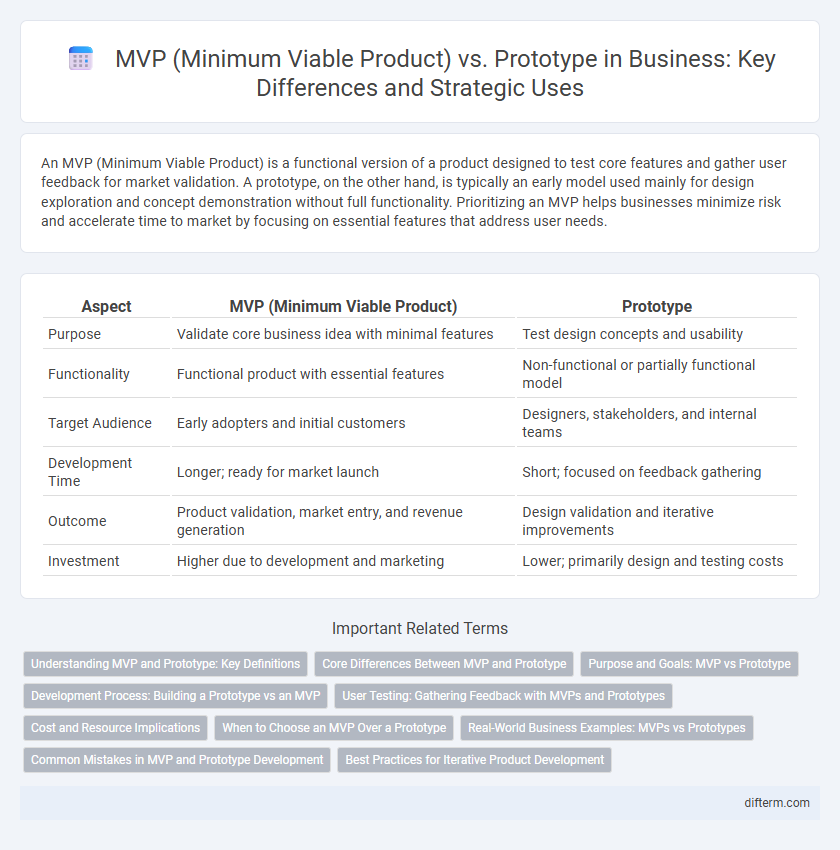An MVP (Minimum Viable Product) is a functional version of a product designed to test core features and gather user feedback for market validation. A prototype, on the other hand, is typically an early model used mainly for design exploration and concept demonstration without full functionality. Prioritizing an MVP helps businesses minimize risk and accelerate time to market by focusing on essential features that address user needs.
Table of Comparison
| Aspect | MVP (Minimum Viable Product) | Prototype |
|---|---|---|
| Purpose | Validate core business idea with minimal features | Test design concepts and usability |
| Functionality | Functional product with essential features | Non-functional or partially functional model |
| Target Audience | Early adopters and initial customers | Designers, stakeholders, and internal teams |
| Development Time | Longer; ready for market launch | Short; focused on feedback gathering |
| Outcome | Product validation, market entry, and revenue generation | Design validation and iterative improvements |
| Investment | Higher due to development and marketing | Lower; primarily design and testing costs |
Understanding MVP and Prototype: Key Definitions
A Minimum Viable Product (MVP) is a functional version of a product with just enough features to satisfy early users and gather valuable feedback for future development. A prototype serves as a preliminary model used primarily to visualize and test design concepts before moving to full-scale development. Understanding the distinction between MVP and prototype is crucial for efficient resource allocation and iterative product improvement in business strategy.
Core Differences Between MVP and Prototype
MVP (Minimum Viable Product) is a functional version of a product with essential features designed to test market demand and gather user feedback, whereas a prototype serves primarily as an early model to visualize design concepts and validate technical feasibility without full functionality. MVP aims to deliver real value to users and enable early revenue generation, while prototypes focus on experimentation and iterative design improvements. The core difference lies in MVP's market readiness for deployment versus the prototype's role as a development tool for concept validation.
Purpose and Goals: MVP vs Prototype
The Minimum Viable Product (MVP) aims to validate core business hypotheses by delivering a functional product with essential features to early adopters, facilitating real user feedback and market testing. In contrast, a Prototype primarily serves as a preliminary model to explore design concepts, gather initial stakeholder input, and identify potential technical challenges without full functionality. While MVPs focus on market validation and iterative improvement, Prototypes emphasize concept exploration and feasibility assessment.
Development Process: Building a Prototype vs an MVP
A prototype is a preliminary model created to validate design concepts and test specific functionalities without full functionality, often used for internal feedback and iteration. An MVP (Minimum Viable Product) involves developing a fully functional product with core features that address key user needs, enabling real-market testing and early customer acquisition. The development process for a prototype focuses on rapid exploration and refinement, while MVP development emphasizes delivering value and usability to validate market demand.
User Testing: Gathering Feedback with MVPs and Prototypes
User testing with MVPs focuses on validating the core functionalities to gather actionable feedback from early adopters, enabling rapid iterations based on real user behavior. Prototypes facilitate qualitative insights by testing design concepts and user interactions without full backend implementation, helping refine usability before development. Both approaches prioritize user feedback but differ in fidelity and scope, with MVPs offering a functional product and prototypes serving as low-fidelity models for evaluation.
Cost and Resource Implications
Developing a Minimum Viable Product (MVP) often requires higher initial costs and more resources compared to a prototype, as it involves creating a functional product intended for market testing and customer feedback. Prototypes typically demand fewer resources and lower investment since they focus on validating specific features or concepts rather than delivering a complete experience. Allocating budget and team effort strategically between prototypes and MVPs can optimize product development efficiency and reduce overall financial risk.
When to Choose an MVP Over a Prototype
Choosing an MVP over a prototype is ideal when you aim to validate a product's market demand with a functional version that delivers core features to early users. MVPs facilitate real user feedback and data-driven iterations, essential for startups seeking investor validation and market fit. Prototypes suit early-stage conceptual testing, but MVPs support scalable growth by combining usability and measurable customer engagement.
Real-World Business Examples: MVPs vs Prototypes
MVPs prioritize launching a functional product to quickly test market demand and gather user feedback, as seen with Dropbox's initial video demonstration validating concept feasibility before full development. Prototypes focus on exploring design ideas and technical feasibility without full market readiness, exemplified by Tesla's early Roadster prototype showcasing electric vehicle technology without mass production intent. Companies leverage MVPs to minimize time-to-market and financial risk, while prototypes serve as internal tools for innovation and refinement in product development cycles.
Common Mistakes in MVP and Prototype Development
Common mistakes in MVP and prototype development include misunderstanding their distinct purposes, such as treating prototypes as final products or overbuilding MVPs with unnecessary features. Entrepreneurs often neglect user feedback during iterative cycles, resulting in products that fail to address market needs. Failing to define clear success metrics and target audience can also lead to wasted resources and delayed product-market fit.
Best Practices for Iterative Product Development
MVP (Minimum Viable Product) emphasizes delivering a functional, market-ready solution with core features to validate business hypotheses, while prototypes serve as preliminary models primarily for design validation and user feedback. Best practices for iterative product development include continuous user testing, rapid feature refinement based on real-world data, and prioritizing scalability and performance in MVP stages to ensure market fit. Employing both MVP and prototypes strategically accelerates learning cycles and minimizes development risks in dynamic business environments.
MVP (Minimum Viable Product) vs Prototype Infographic

 difterm.com
difterm.com